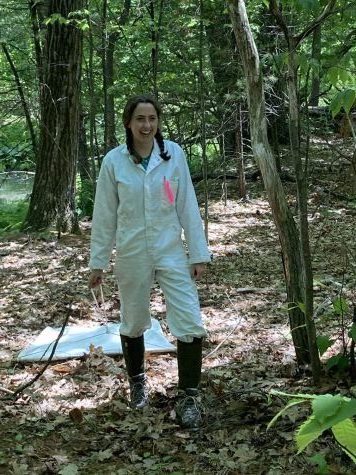Steinmetz Research Spotlight: Sasha Milsky
April 6, 2022
 This week’s Steinmetz Spotlight is Sasha Milsky ‘22, a biology major studying the isotopic variation in White-footed Mouse and Eastern Chipmunk fur and its relationship to disease cycles of tick-borne diseases.
This week’s Steinmetz Spotlight is Sasha Milsky ‘22, a biology major studying the isotopic variation in White-footed Mouse and Eastern Chipmunk fur and its relationship to disease cycles of tick-borne diseases.
She writes about her project, “The prevalence of tick-borne diseases has been fluctuating across the United States, calling attention to the need to better understand the importance of various host species in maintaining these disease cycles. Here, I built upon previous research exploring the use of stable isotopes as a method to identify previous hosts of Ixodes scapularis (Black-legged Tick). Due to the difficulty in collecting ticks from hosts consuming natural diets, I investigated the isotopic variability in fur, a tissue with some isotopic similarity to the red blood cells that ticks consume. I also examined “tick-fur spacing”, or the difference in δ13C and δ15N isotopic signatures from the host fur to the molted tick. First, I generated an isotopic library of fur signatures from nine common tick host species (average 3-4 samples/species). Logistic regression revealed difficulty in identifying a fur sample accurately to its species, likely due to high dietary overlap between ecologically similar host species. Therefore, species were grouped by feeding guild. A logistic regression model at the guild level assigned fur samples to the correct guild 58% to 91% of the time. This variability is likely due to opportunistic feeding. To make use of this library as a reference to determine previous tick hosts, I examined whether there was a standard value for tick-fur spacing. To do this, I trapped and held Peromyscus leucopus (White-footed Mice) and Tamias striatus (Eastern Chipmunks) in our vivarium. There, I collected fur samples and ticks that dropped from each individual within 12 hours of capture and were thus reflective of the host’s wild diet. Tick-fur spacing values were quite variable (δ15N range: 1.47‰ to 5.63‰; mean=3.24‰ ± 1.14 (SD); δ13C range: -2.61 to 1.39, mean=-0.73 ± 0.76), so more study is needed to determine the utility of a fur library for this technique. Overall, intraguild variability limits the utility of this approach, but in the absence of more host-specific molecular techniques, it may shed light on host preferences of I. scapularis.”






